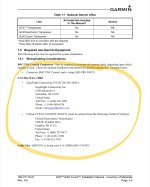Howdy Braintrust,
I got the first engine start completed on my RV-10 build and almost everything is working great, but I’m having a canbus issue that I think is isolated to my autopilot servos.
My electrical system was wired and designed by steinair and is a full G3X system. With everything plugged in, I get network errors on the canbus and my roll autopilot servo isn’t even detected by the system. My pitch servo and yaw damper servo both also show hardware failures. The status lights on the servos themselves are solid green for roll (not detected by system), and solid red for pitch and for yaw damper.
I originally thought that it must be the canbus wiring from the roll servo since it’s the one not being detected. Of note, my canbus termination points are the roll servo and the yaw damper servo. Interestingly, if I put one of those canbus terminator plugs on the harness at the roll servo, all of my LRUs show green with 0 network error. The only errors I get in this case are the hardware failed pitch and yaw damper servos. I checked all of the breakpoints to the servos for wiring, and they are all correct. No mismatched pins.
I’m at a bit of a loss. My servos are old (-00) old, but have never been used. I’m working to replace them under the new SB, but Garmin won’t do a direct RMA to Canada, so I’m looking for a dealer to facilitate.
I feel like it’s unlikely that a servo itself is causing canbus network issues, but with it showing no error with the toll servo capped, I also feel like the wiring must also be good. Anyone seen a canbus issue caused by faulty autopilot servos? Garmin said that would be exceedingly rare, as would having 3 bad servos all at once (even with them all being old).
What do you pros think?
I got the first engine start completed on my RV-10 build and almost everything is working great, but I’m having a canbus issue that I think is isolated to my autopilot servos.
My electrical system was wired and designed by steinair and is a full G3X system. With everything plugged in, I get network errors on the canbus and my roll autopilot servo isn’t even detected by the system. My pitch servo and yaw damper servo both also show hardware failures. The status lights on the servos themselves are solid green for roll (not detected by system), and solid red for pitch and for yaw damper.
I originally thought that it must be the canbus wiring from the roll servo since it’s the one not being detected. Of note, my canbus termination points are the roll servo and the yaw damper servo. Interestingly, if I put one of those canbus terminator plugs on the harness at the roll servo, all of my LRUs show green with 0 network error. The only errors I get in this case are the hardware failed pitch and yaw damper servos. I checked all of the breakpoints to the servos for wiring, and they are all correct. No mismatched pins.
I’m at a bit of a loss. My servos are old (-00) old, but have never been used. I’m working to replace them under the new SB, but Garmin won’t do a direct RMA to Canada, so I’m looking for a dealer to facilitate.
I feel like it’s unlikely that a servo itself is causing canbus network issues, but with it showing no error with the toll servo capped, I also feel like the wiring must also be good. Anyone seen a canbus issue caused by faulty autopilot servos? Garmin said that would be exceedingly rare, as would having 3 bad servos all at once (even with them all being old).
What do you pros think?





